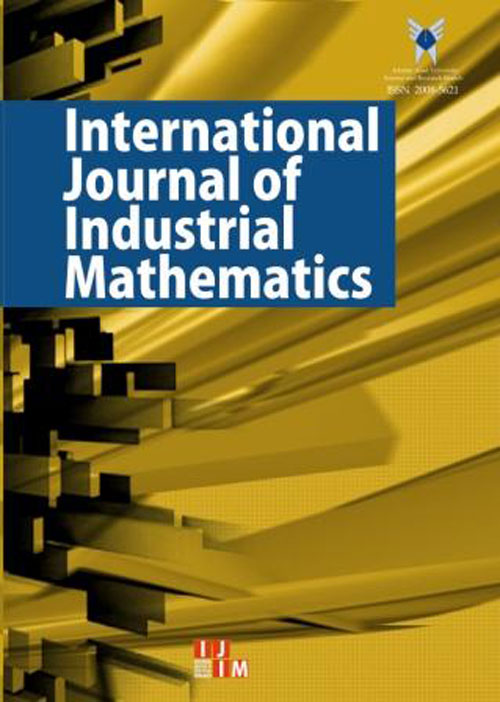فهرست مطالب

International Journal of Industrial Mathematics
Volume:12 Issue: 3, Spring 2020
- تاریخ انتشار: 1399/04/14
- تعداد عناوین: 10
-
-
Pages 205-213
In the present paper, by considering the notion of ideals in MV -algebras, we study some kinds of ideals in MV -algebras and obtain some results on them. For example, we present definition of ultra ideal in MV -algebras, and we get some results on it. In fact, by definition of ultra ideals, we present new conditions to have prime ideals, positive implicative ideals and maximal ideals in MV -algebras. Also, we state some properties on contracted or extended ideals as useful examples of ideals in MV -algebras. Finally, we try to prove the Chines reminder theorem in MV -algebras.
Keywords: $MV$-algebra, Ideal, Ultra ideal, Chines reminder theorem, Pseudo-hoops -
Pages 215-223A nonlinear chattering-free sliding mode control method is designed to stabilize fractional chaotic systems with model uncertainties and external disturbances. The main feature of this controller is rapid convergence to equilibrium point, minimize chattering and resistance against uncertainties. The frequency distributed model is used to prove the stability of the controlled system based on direct method of Lyapunov theory. Numerical simulations are presented to illustrate the effectiveness of the method.Keywords: Fractional-order systems, Sliding mode control, frequency distributed model, stabilization
-
Pages 225-237In this paper, it is shown that the solution vector obtained by the classic Crout decomposition method is not an algebraic solution of a fuzzy complex linear system. Here, we propose a limited version of the mentioned method to obtain an algebraic solution of a fuzzy complex linear system (if it exists). Two numerical examples are presented to show ability and reliability of our method.Keywords: Fuzzy complex number, Fuzzy complex linear system, Limited Crout decomposition method, Fuzzy number, Linear equations
-
Pages 239-244
Since complex interval matrix have many applications in different fields of science, in this paper interval complex matrix system as [W][Z] = [K] in which [W], [K] are n × n known interval complex matrices and [Z] is n × n unknown interval complex matrix is studied. Using operations on interval complex numbers and matrices and defining a theorem, two auxiliary addition and subtraction complex systems are introduced and proved. Then, using the equality property of two complex numbers, the auxiliary interval complex systems are transformed to real crisp systems. Then the new system is solved and [Z] is achieved. Finally, some numerical examples are given to illustrate the applicability and ability of the proposed approach
Keywords: Interval linear system, Interval complex number, Matrix system, Complex number, Crisp systems -
Pages 245-261Regular NDEA models for calculating the efficiency of DMUs with two-stage construction requires the data set to be deterministic. In the real world, however, there are many observations that have stochastic behavior. This paper proposes a network DEA with two-stage structures models by the attention to stochastic data. The stochastic two-stage network DEA models are formulated based on the P-models of chance constrained programming and leader-follower concepts.Keywords: Stochastic DEA, Chance constraint model, Two-stage system, Performance evaluation
-
Pages 263-271
In this paper, a class of nonlinear fractional partial differential equation is considerd and solved by advanced analytical-numerical methods such as homotopy analytical and Adomian decomposition Methods and Mittag-Leffler functions. The obtained approximate solutions show that these solutions are same for the first three approximate terms u1, u2, u3.
Keywords: Nonlinear fractional differential equation, Mittag-Leffler functions, Adomian Decomposition Method, Homotopy Analytical Method -
Pages 273-382
In this paper, we propose direct methods to solve linear delay differential equations (DDEs) based on vector forms of Block-Pulse Functions (BPFs) and Triangular Functions (TFs). Operational matrix of integration of BPFs and TFs are applied to transform LDDE to a linear system of algebraic equations. Further, some numerical examples are presented to indicate the reliability and accuracy of these methods. Convergence analysis of the present method has been discussed.
Keywords: Linear delay differential equations, Block-Pulse Functions, Triangular Functions, Direct method -
Pages 283-296
In this study, a deterministic mathematical model was used to investigate the dynamics of typhoid disease by using different optimal control strategies. The qualitative behavior of the control profile revealed that prevention has a higher impact in minimizing the incidence of the disease. Finally it was shown that applying all the three control strategies rapidly minimizes typhoid disease from the population.
Keywords: Mathematical model, Typhoid, Basic reproduction number, immunization, Deterministic model -
Pages 297-301
we discuss about the determination of the output levels of a decision-making units with the preference of cone constraints when some of the outputs are undesirable. The output levels of a DMU is estimated when some or all of its input components are increased and its current efficiency level is improved. To estimate the output levels, the inverse data envelopment analysis (DEA) and multi objective linear programming models are used.
Keywords: DEA, MOLP, Undesirable Output, Cone Constraints -
Pages 303-314
In this paper, a novel and practical approach are proposed to solve the fuzzy optimal control (FOC) using an improved multi-layer perceptron (IMLP) network along with the Pontryagin minimum principle (PMP). Here, it is worthwhile to mention that in the fuzzy Hamilton function, instead of functions of control and trajectory and the Lagrange multipliers, the approximate solutions are replaced based on the IMLP neural network, which is a Three-layer type.
Keywords: FOC problem, Pontryagin minimum principle, IMLP networks, BFGs method


